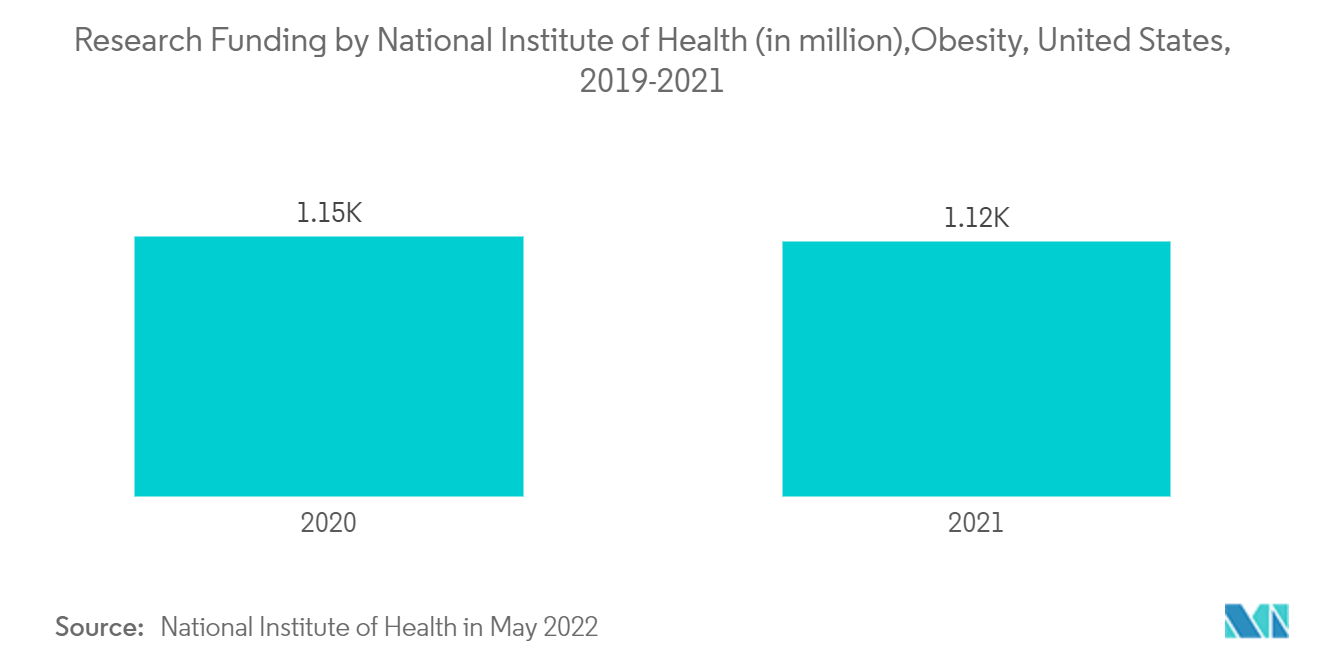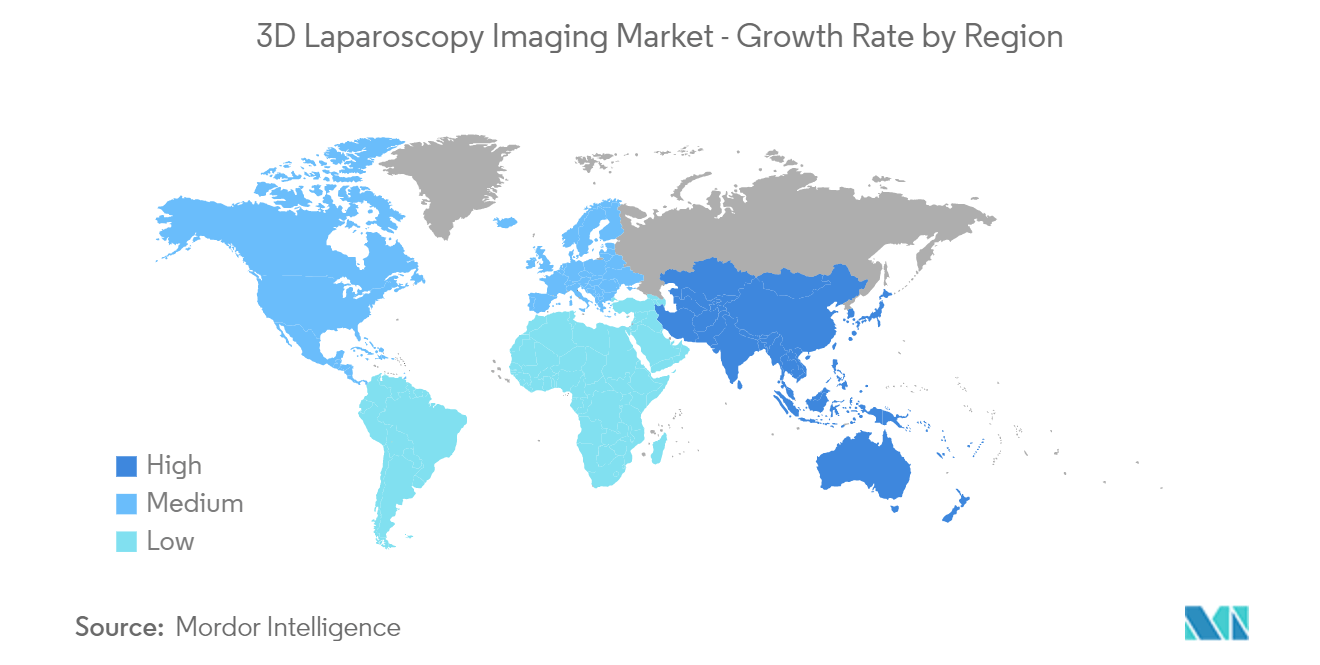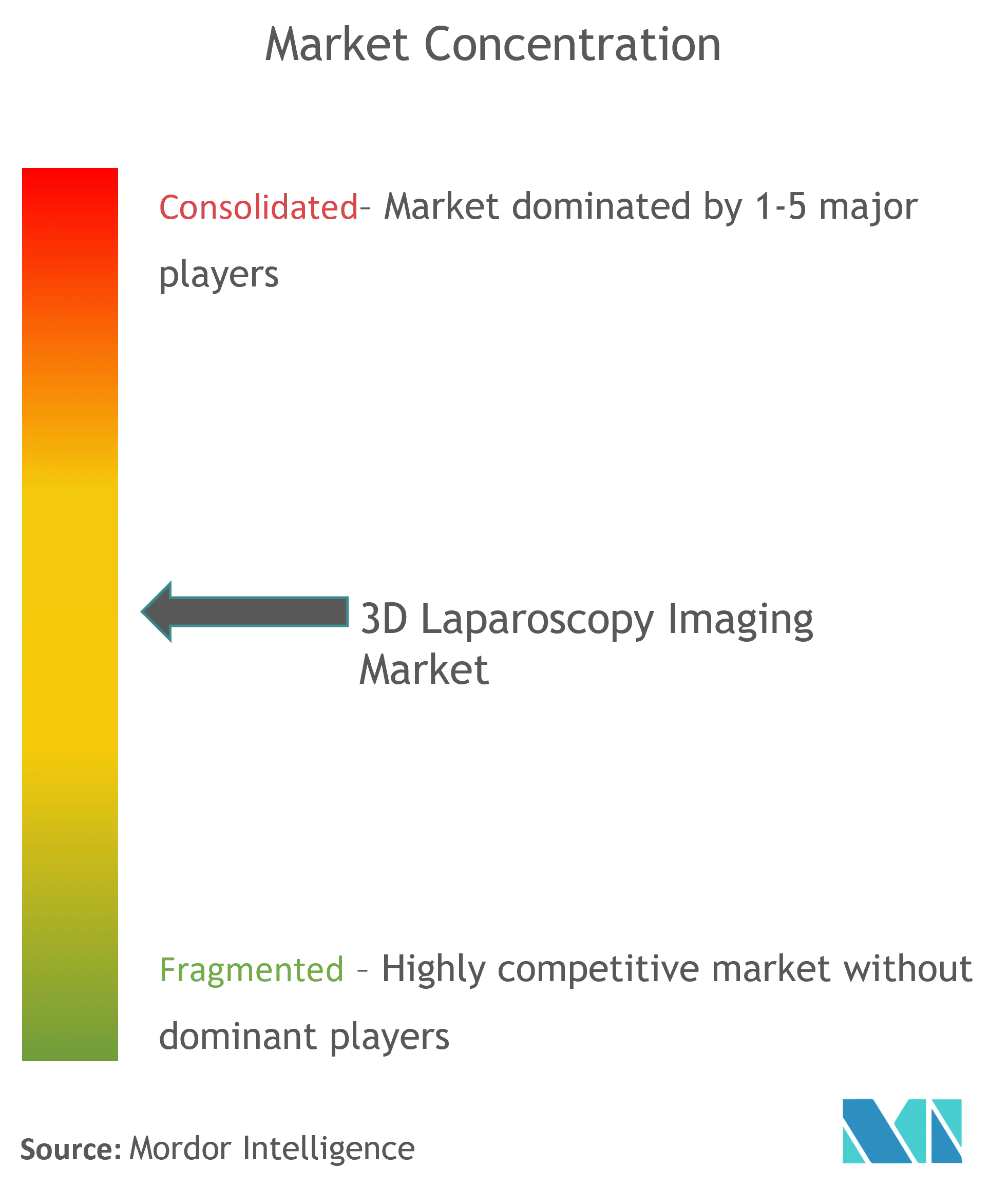3D Laparoscopy Imaging Market Size

| Study Period | 2019 - 2029 |
| Base Year For Estimation | 2023 |
| Forecast Data Period | 2024 - 2029 |
| CAGR | 4.50 % |
| Fastest Growing Market | Asia-Pacific |
| Largest Market | North America |
| Market Concentration | Medium |
Major Players
*Disclaimer: Major Players sorted in no particular order |
3D Laparoscopy Imaging Market Analysis
The 3D laparoscopy imaging market is expected to register a CAGR of nearly 4.5% over the forecast period (2022-2027).
With the outbreak of COVID-19, 3D laparoscopy procedures have seen renewed focus as studies have shown that patients who had undergone bariatric surgeries had a lower risk of hospital and intensive care unit (ICU) admissions. According to the study titled "Association of prior metabolic and bariatric surgery with the severity of coronavirus disease (COVID-19) in patients with obesity" published in the Surgery for Obesity and Related Diseases in January 2021, researchers at the Cleveland Clinic commissioned a study and they came up with the above observation that patients with severe obesity who have histories of metabolic surgery have SARS-CoV-2 infections that are less severe, as shown by lower risks of hospital and ICU admission. This is likely to increase the demand for bariatric procedures, which will eventually positively affect the demand for 3D laparoscopy devices. Moreover, according to the study titled "Laparoscopic Gastrointestinal Surgery During COVID-19 Pandemic: Single-Center Experience" by Bhavin Patel in April 2021, laparoscopic procedures have decreased as a result of the COVID-19 era, making it a risky procedure due to a potential risk of viral transmission. Therefore, a decline in laparoscopic surgery could hinder the laparoscopy imaging market. Consequently, the market was significantly impacted during COVID-19.
The factors driving market growth include increasing preference for and advancements in 3D imaging technology, increase in obesity and rising demand for bariatric surgeries, and rising demand for minimally invasive procedures.
According to the study titled "Must Clinics Replace 2D by 3D Environments for an Efficient Training of Laparoscopic Novices? A Critical Analysis of the Learning Curve for Basic Skills" published in the Frontier in Surgery in January 2022, in a straightforward standardized test, laparoscopic novices showed a significant difference between 2D and 3D technology in performance time and error rate. Thus, surgeons may continue to receive training in both methods in the future. Thus, the growing adoption of 3D technology by the surgeon is anticipated to drive the growth of the market.
In addition, the market is growing as a result of the rising prevalence of obesity and the demand for bariatric surgery. According to the World Health Organization in June 2021, there were 39 million under-five years old kids who were overweight or obese in 2020.Overweight and obesity, once thought to be a problem only in high-income nations are now becoming more prevalent in low- and middle-income nations as well, especially in urban areas. Moreover, World Obesity Atlas March 2022 published by the World Obesity Federation, predicts that by 2030, one billion people worldwide, including one in five women and one in seven men, will have obesity. As a result, the market for 3D laparoscopy imaging market is anticipated to grow over the projection period due to the rising prevalence of obesity and the increased need for the procedure.
In addition, a conventional laparoscopic camera consists of only a 2-Dimensional (2D) system and although there is an improvement in graphics from a high definition (HD) system, there is still a lack of depth and spatial perception. 3-Dimensional (3D) systems can potentially improve laparoscopic training by eliminating the need to overcome the loss of stereoscopic vision likely to affect market growth positively. For instance, in January 2020, Karl Storz SE & Co. KG launched a new 3D surgical imaging system with a modular camera platform. The new system allows for better visualization of microsurgical and open interventions in different surgical fields.
Thus, all aforementioned factors are anticipated to boost the market growth over the forecast period. However, the high costs associated with the products restrain the market growth.
3D Laparoscopy Imaging Market Trends
This section covers the major market trends shaping the 3D Laparoscopy Imaging Market according to our research experts:
Bariatric Surgery is Expected to Hold Significant Market Share by Application Over the Forecast Period
Due to the increasing number of bariatric surgeries performed, the market will continue to grow. The application scope of 3D laparoscopy imaging systems is likely to expand in bariatric surgeries, as surgeons require a stereoscopic vision of anatomy for an accurate dissection prior to surgery.
According to the World Health Organization's report published in June 2021, One in five children and adolescents globally are overweight. Incidences of obesity have been increasing fiercely over the past decades, and it is often described as a global endemic, especially in developed countries where lifestyle-related disorders, such as anxiety, stress, smoking, and drinking, are more prevalent. Furthermore, as per the study titled "Bariatric and Metabolic Surgery in India: Where Do We Stand?" published in the Indian Journal of Surgery in January 2022, a total of 833,687 bariatric procedures were performed around the world in 2020. in addition as per the same source, Over 1.9 billion adults worldwide are overweight, with 650 million being obese. Thus, the high burden of obesity and rising in the number of bariatric surgery performed across globe anticipated to drive the demand of 3D laparoscopy imaging thereby boost the segment growth.
Obesity is also associated with substantial increases in premature mortality, impaired quality of life, and substantial costs of healthcare. The major comorbidities include hypertension, Type-2 diabetes, dyslipidaemia, myocardial infarction, certain cancers, stroke, sleep apnea, and osteoarthritis. Most of the comorbidities are the leading causes of death too.
Thus, increase the safety of the bariatric surgical techniques, driving the growth of the segment in the market.

North America Dominates the Market and is expected to continue so Over the Forecast Period
North America dominates the 3D laparoscopic imaging market over the forecast period. This can be attributed to a growing preference for laparoscopic surgery over open surgery, as well as increased awareness of the advantages of minimally invasive procedures. Furthermore, product innovation competition among major players will have an impact on the market.
Furthermore, the market is being propelled forward by a growing demand for minimally invasive 3D laparoscopic equipment. Because of the less trauma they cause, minimally invasive surgical methods are becoming more popular. For example, in December 2020, Olympus reported that their VISERA ELITE II surgical imaging platform for minimally invasive surgery will now include 3D and infrared capabilities. The addition of a platform like this could aid hospitals and operation centers in increasing efficiency and lowering costs. Gynecology, general surgery, orthopedic surgery, endourology, and ENT are just a few of the applications for the product. Furthermore, health insurance companies in some countries pay for minimally invasive laparoscopic surgeries. According to the Medicare Benefits Schedule march 2022, up to 75% of laparoscopic procedures are now covered by Medicare (MBS). As a result of these considerations, patients' preferences for minimally invasive surgeries have increased.
Moreover, increasing prevalence of obesity in the region anticipated to boost the market. In September 2020, the Centers for Disease Control and Prevention (CDC) May 2022, the prevalence of obesity in the United States increased from 30.5 to 41.9%. The prevalence of severe obesity rose from 4.7 percent to 9.2%. Moreover, As per United States National Health Statistics Reports published in June 2021, among adults aged 20 and over, the prevalence of obesity was 41.9%, severe obesity was 9.2%, and diabetes was 14.8%. The increase in the prevalence of obesity among the population is expected to drive the bariatric surgery market in the United States.Thus, increasing prevalence of the obesity and rising in spending of its treatment anticipated to boost the market growth.
Launch of technological advanced productby the key market players expected to grow the market over the forecast period. In December 2020, Olympus Corporation released an upgraded version of its rigid 3D ENDOEYE video laparoscope, which allows surgeons greater control than conventional 3D laparoscopes. The upgrade provides true horizon orientation for surgeons.
Hence, the rising demand for 3D laparoscopic imaging for bariatric and urologic surgeries is expected to propel the market growth in the region.

3D Laparoscopy Imaging Industry Overview
The global 3D laparoscopy imaging market is moderately competitive and consists of a few major players. Companies like Olympus Corporation, Sometech, Inc., Karl Storz SE & Co. KG, B. Braun Melsungen AG, Fujifilm Healthcare, Medtronic, and Siemens Healthineers, among others, hold the substantial market share in the 3D laparoscopy imaging market.
3D Laparoscopy Imaging Market Leaders
-
Olympus Corporation
-
Karl Storz SE & Co. KG
-
Somatech Inc.
-
B. Braun Melsungen AG
-
Siemens Healthineers
*Disclaimer: Major Players sorted in no particular order

3D Laparoscopy Imaging Market News
- In November 2021, Shanghai MicroPort MedBot (Group) Co., Ltd. (MicroPort MedBot) recently attended the 28th National Seminar for Laparoscopic Surgery Demonstration, to launch their DFVision 3D Electronic Laparoscope (DFVision). The event - a grand academic gathering in the field of laparoscopy in China was attended by industry experts and live broadcasted online, garnering over 59,000 views.
- In November 2021, OMNIVISION Technologies, Inc., one of the leading developer of advanced digital imaging solutions, and Diaspective Vision GmbH, a developer of high quality hyperspectral and multispectral camera systems for medical applications, formed a partnership in the development of a new type of endoscopic camera, the MALYNA system, which is based on proprietary multispectral imaging technology.
3D Laparoscopy Imaging Market Report - Table of Contents
1. INTRODUCTION
1.1 Study Assumptions and Market Definition
1.2 Scope of the Study
2. RESEARCH METHODOLOGY
3. EXECUTIVE SUMMARY
4. MARKET DYNAMICS
4.1 Market Overview
4.2 Market Drivers
4.2.1 Increasing Preference for and Advancements of 3D Imaging Technology
4.2.2 Rise in Obesity and Increase in Demand for Bariatric Surgeries
4.2.3 Rising Demand for Minimally Invasive Procedures
4.3 Market Restraints
4.3.1 High Cost Associated with the Products
4.4 Porter's Five Forces Analysis
4.4.1 Threat of New Entrants
4.4.2 Bargaining Power of Buyers/Consumers
4.4.3 Bargaining Power of Suppliers
4.4.4 Threat of Substitute Products
4.4.5 Intensity of Competitive Rivalry
5. MARKET SEGMENTATION (Market Size by Value - USD Million)
5.1 By Application
5.1.1 Gynecological Surgery
5.1.2 Bariatric Surgery
5.1.3 Urological Surgery
5.1.4 Other Applications
5.2 By End User
5.2.1 Hospitals
5.2.2 Ambulatory Surgical Centers
5.2.3 Other End Users
5.3 Geography
5.3.1 North America
5.3.1.1 United States
5.3.1.2 Canada
5.3.1.3 Mexico
5.3.2 Europe
5.3.2.1 Germany
5.3.2.2 United Kingdom
5.3.2.3 France
5.3.2.4 Italy
5.3.2.5 Spain
5.3.2.6 Rest of Europe
5.3.3 Asia-Pacific
5.3.3.1 China
5.3.3.2 Japan
5.3.3.3 India
5.3.3.4 Australia
5.3.3.5 South Korea
5.3.3.6 Rest of Asia-Pacific
5.3.4 Middle-East and Africa
5.3.4.1 GCC
5.3.4.2 South Africa
5.3.4.3 Rest of Middle-East and Africa
5.3.5 South America
5.3.5.1 Brazil
5.3.5.2 Argentina
5.3.5.3 Rest of South America
6. COMPETITIVE LANDSCAPE
6.1 Company Profiles
6.1.1 Olympus Corporation
6.1.2 Sometech Inc.
6.1.3 Karl Storz SE & Co. KG
6.1.4 B. Braun Melsungen AG
6.1.5 Conmed Corporation
6.1.6 Medtronic Plc
6.1.7 Siemens Healthineers
6.1.8 Stryker Corporation
6.1.9 Johnson & Johnson Medical Devices
6.1.10 Richard Wolf GmbH
6.1.11 Xion Medical
6.1.12 Pentax Medical
6.1.13 Fujifilm Healthcare
- *List Not Exhaustive
7. MARKET OPPORTUNITIES AND FUTURE TRENDS
3D Laparoscopy Imaging Industry Segmentation
The 3D view provides depth perception and correct measurement of the dimensions of the anatomical spaces contributing to increasing the skills of the laparoscopic surgeon to turn tissues, dissect, design surgical strategies, and perform intracorporeal sutures. 3D imaging is a novel technology in laparoscopic surgery, and recent studies have shown that modern 3D techniques are superior in an experimental setting. 3D imaging in laparoscopy offers various advantages by improving coordination, spatial awareness, and timing in comparison to traditional 2D imaging. The 3D laparoscopy imaging market is segmented by Application (Gynecological Surgery, Bariatric Surgery, Urological Surgery, and Other Applications), End User (Hospitals, Ambulatory Surgical Centers, and Other End Users), and Geography (North America, Europe, Asia-Pacific, Middle East and Africa, and South America). The market report also covers the estimated market sizes and trends for 17 different countries across major regions, globally. The report offers the value (in USD million) for the above segments.
| By Application | |
| Gynecological Surgery | |
| Bariatric Surgery | |
| Urological Surgery | |
| Other Applications |
| By End User | |
| Hospitals | |
| Ambulatory Surgical Centers | |
| Other End Users |
| Geography | ||||||||
| ||||||||
| ||||||||
| ||||||||
| ||||||||
|
3D Laparoscopy Imaging Market Research FAQs
What is the current Global 3D Laparoscopy Imaging Market size?
The Global 3D Laparoscopy Imaging Market is projected to register a CAGR of 4.5% during the forecast period (2024-2029)
Who are the key players in Global 3D Laparoscopy Imaging Market?
Olympus Corporation, Karl Storz SE & Co. KG, Somatech Inc., B. Braun Melsungen AG and Siemens Healthineers are the major companies operating in the Global 3D Laparoscopy Imaging Market.
Which is the fastest growing region in Global 3D Laparoscopy Imaging Market?
Asia-Pacific is estimated to grow at the highest CAGR over the forecast period (2024-2029).
Which region has the biggest share in Global 3D Laparoscopy Imaging Market?
In 2024, the North America accounts for the largest market share in Global 3D Laparoscopy Imaging Market.
What years does this Global 3D Laparoscopy Imaging Market cover?
The report covers the Global 3D Laparoscopy Imaging Market historical market size for years: 2019, 2020, 2021, 2022 and 2023. The report also forecasts the Global 3D Laparoscopy Imaging Market size for years: 2024, 2025, 2026, 2027, 2028 and 2029.
Hernia Repair Devices Industry Report
Statistics for the 2024 Hernia Repair Devices market share, size and revenue growth rate, created by Mordor Intelligence™ Industry Reports. Hernia Repair Devices analysis includes a market forecast outlook 2029 and historical overview. Get a sample of this industry analysis as a free report PDF download.



